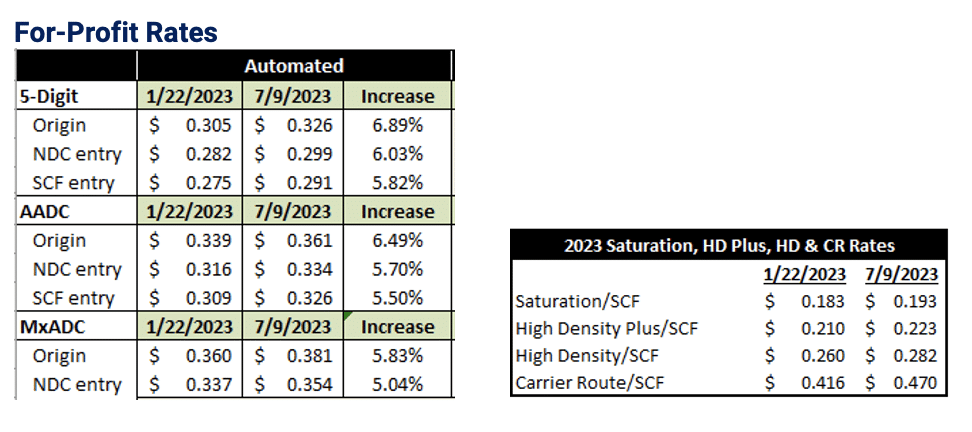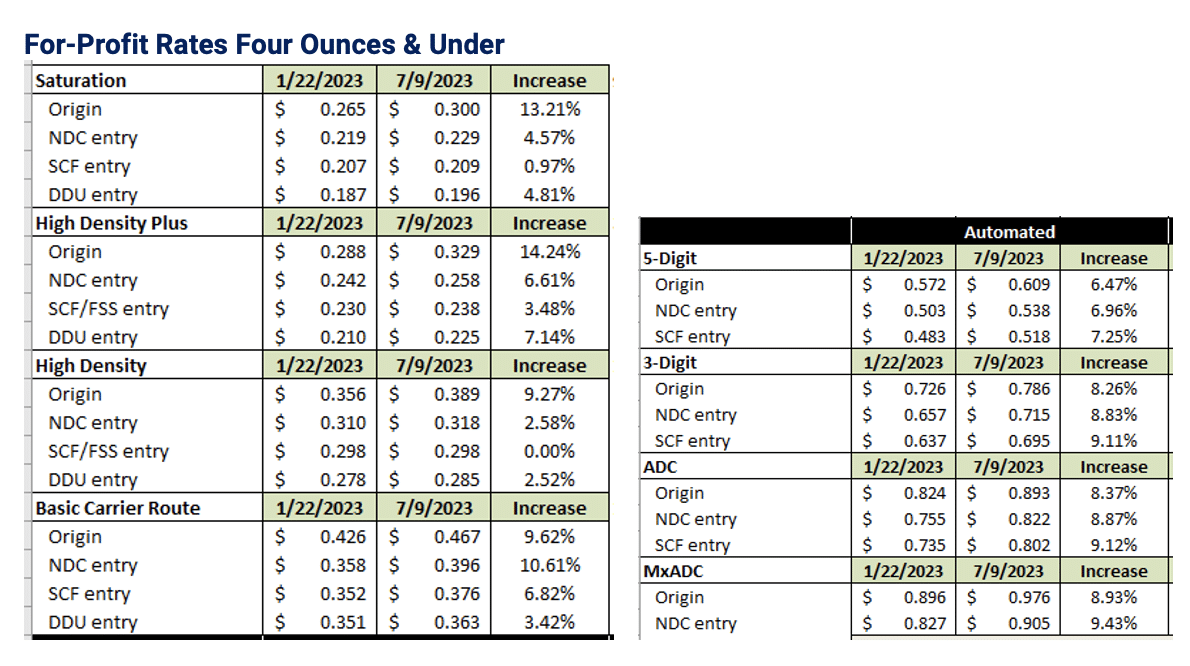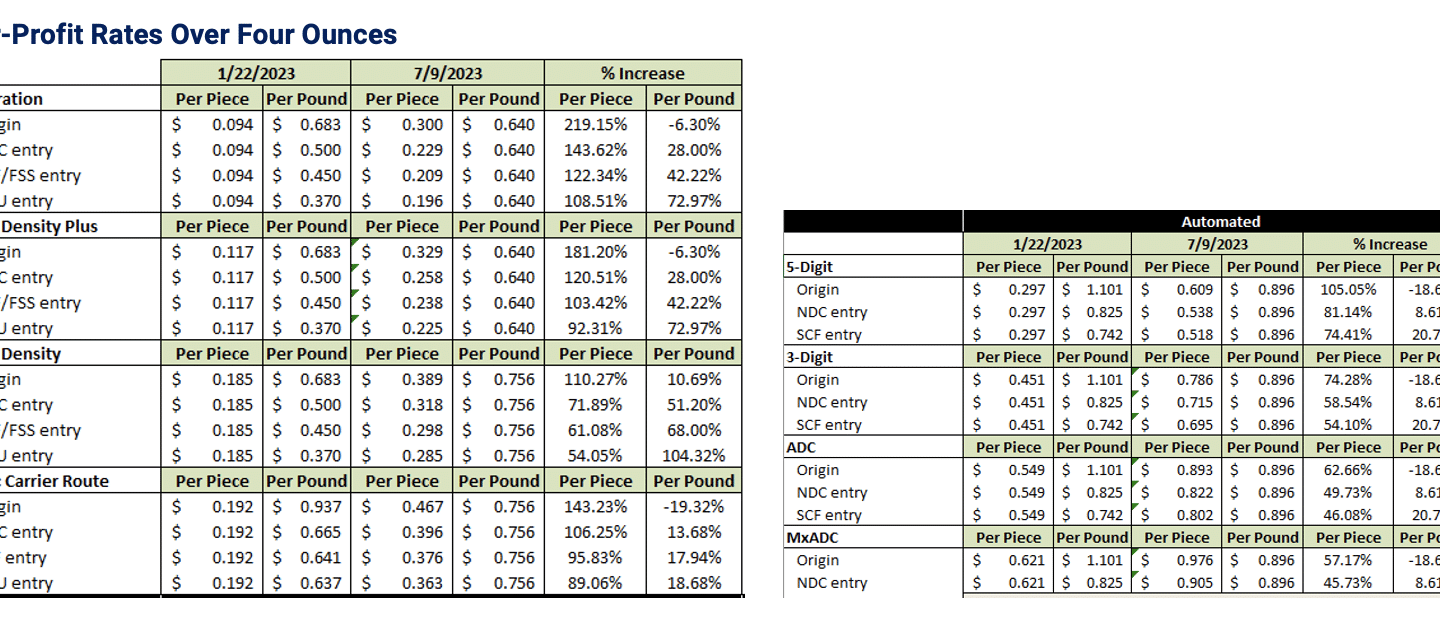It’s hard to believe that we’re already wrapping up the calendar year, and looking ahead to 2024! As the New Year rolls around, we thought it would be helpful to remind everyone about increases effective January 21, 2024.
In speaking with Tom, we were reminded about the Postal Service’s proposed postal rates that were filed back in October. Before you continue… we want to warn you, the increases are detailed! There are many! But, Tom and our team are here to work through them with you. Together we will optimize your direct mail investment with the end goal of growing your business.
Here’s a preview of what’s included in this update:
- – Modest postage increases, 1.37% for letters, 5% – 6% for flats (catalogs) effective 1/21/2024
- – Flats are seeing larger increases because they are not meeting their costs within the USPS
- – Heavier flats (10 – 16 ounces) will see lower increases, just under 4% on average
- – USPS is increasing discounts offered on 5-Digit scheme and SCF pallets to offset increases
- – Similar increases with first class mail, 3% for a 1-ounce letter & postcards are less than 1%
- – USPS promotions are a must for Direct Mailers to help keep costs in check
- – All Direct Mailers should sign up for the 2024 Mail Volume Incentive Program
- – Anticipate much larger increases in the range of 7% – 9.5% with the next increase expected in early July 2024
If you got what you need from our summary, great! If we didn’t scare you off, read on!
What you need to know about the January 2024 postage increases
The USPS has put into place the following increases in their postal categories. Keep in mind that while these percentages are overall changes, specific sortation increases will be larger in some areas than others creating fluctuations from these announced increases.
USPS Published Rate Increases by Class
First Class Mail 1.969%
Marketing Mail 1.961%
Periodicals 1.959%
Package Services 1.960%
Marketing Mail Increases
Letters 1.333%
Flats (catalogs) 3.966%
Parcels 20.029%
High Density/Saturation Letters 1.073%
High Density/Saturation Flats 2.144%
Carrier Route 3.963%
Every Door Direct (EDDM) 2.525%
The January 2024 increase seems to be a consistent increase across all sortation levels within a given class of mail. The reason why Flats & Carrier-Route Marketing Mail in increasing at a larger rate than other classes is because these are considered non-compensatory or under water products and are impacted with additional increases. For Flats, direct mailers can expect to see slightly higher increases at the high density, basic carrier route and 5-digit rates.
Letter Mail
Most letters mail optimally at a 5-Digit/SCF entry mail. The 5D/SCF for-profit rate is increasing a modest 1.37% to $0.295/pc with non-profit rates increasing 1.47% to $0.138/pc. Drop Ship discounts offered to mailers who entering mail at the destination, are not changing from current rates.
For-Profit Letter Rates

Flats – Four Ounces & Under
Basic Carrier Route mail will see the above average increases (4.792% at the SCF entry-level), and High Density/SCF entered mail will also see an above average increase of 6.04%. High Density rates did not increase with the last July 2023 USPS change. Good news – drop ship discounts are not changing from current rates. Non-profit rates, four ounces and under, will see lower increases than for-profit mail after experiencing higher percentages increases than for-profit mail in the last few years.
For-Profit Rates 4 Ounces & Under


To better understand the comparison of before and after rates, here are a few for-profit sortation scenarios calculated at different piece weights:



Heavier catalogs will see lower percentage increases that books closer to four ounces.
Flats Postal Discounts
The USPS is again offering higher discounts for Mailers creating SCF and Five-Digit pallets


First Class Mail
- – A stamped one-ounce letter has increased to $0.68/pc from $0.66/pc (3.03% increase)
- – First class flats have increased 1.44%
- – First class postcards have increased to $0.357/pc from $0.355/pc (<1% increase)
USPS Promotions
At Media Horizons, we believe strongly in strategically using the USPS discount promotions to your advantage. As your partners, we can help you identify the promotions and determine how best to use them to ultimately achieve your goals. Here’s the latest:
- – Tactile, Sensory & Interactive – 5% USPS incentive for Marketing Mail & First-Class Mail – 2/1/2024 – 7/31/2024
- – Personalized Color Transpromo – 3% or 4% USPS incentive for First Class Mail – February 1st – July 31st
- – Emerging & Advanced Technology – 3% to 4% USPS incentive for Marketing Mail & First-Class Mail
NEW – Direct Mailer can pick the 6-month window they would like to use this promotion
- – Reply Mail IMbA – 3% USPS incentive for First Class Mail – July 1st – December 31st
- – Informed Delivery – 4% USPS incentive for Marketing Mail & First-Class – August 1st – December 31st
The mail preparer also receives a 0.5% incentive from the USPS
- – Retargeting Mail – 5% USPS incentive for First-Class Mail – September 1st – November 30th
We’d love to have a conversation about your direct mail campaign, but if you want to quickly scan through the latest details, here they are! Most important takeaways: Beginning in 2025, the mobile shopping incentive will no longer be available and the gloss paper qualification will no longer be available.
Dates to mark on your calendar!
December 2024 – Mobile Shipping Advanced Technology Promotion
Did you know that there are no USPS promotions going to be offered for this coming January? On December 15th, customers should sign up for the Emerging & Advanced Technology Promotion, which can be taken during any consecutive six-month period next year. Included in this promotion is the Mobile Shopping application. By placing a mobile optimized QR code within the mail piece, the USPS is offering a 3% postage incentive during a month that does not have incentives available. The Mobile Shopping incentive offers a no-cost solution to save postage dollars. More information on this promotion is available here.
February 2024 – July 2024 – Coated Paper for the Tactile Promotion
We recommend that customers mailing on coated paper sign up for the Tactile, Sensory & Interactive promotion. The USPS offers a 5% postage incentive for simply using gloss coated paper. All opportunities will be approved in advance by the USPS through their Mailing Promotions Portal (MPP). Many customers are already using gloss coated paper, so this incentive offers a potential no cost solution. Who doesn’t love a no cost solution?! If gloss coated paper is not being used or other interactive marketing elements are desired, the USPS is offering the incentive for the use of specialty inks, sensory treatments, or interactive elements. Pro tip: registration for this promotion also begins December 15th. More information on this promotion is available here.
August 2024 – December 2024 – Informed Delivery Promotion
Filling out the year, another no cost solution that offers a 4% postage incentive is Informed Delivery. Customers can sign up for this promotion starting June 15th. There is a little preparation work required to set up each campaign, but a 4% incentive is nice reward for a little amount of additional work that is required. More information on this promotion is available here.
Overall 2024 USPS Mail Volume Incentive
Lastly, we recommend that everyone sign up for the 2024 USPS Volume Incentive Program. The USPS will be offering a volume growth incentive rewarding customers for 2024 growth in pieces mailed compared with their 2023 volume baseline. The minimum baseline volume will be set at the Mail Owners actual volume or a minimum one million pieces and they are offering up to a 30% rebate on the growth to be used on future mailings after exceeding their volume threshold.
Another date to mark on your calendar! Registration will begin in November 2023, including a verification and approval process by the Mail Owner to the USPS agreeing on the designated baseline volume. The baseline period is marketing mail and first-class pieces mailed from October 2022 through September 2023. Marketing mail and first-class mail volume will be measured separately from one another and will not be combined.
Postage rebates will be applied towards future mailing through December 2025 with potential credits becoming available in July 2024, October 2024 or February 2025.
These are the newer promotions that stuck out to us. There are others available, such as reply mail, retargeting, etc., which are just as important!
Whew! You made it through. Thanks for sticking with us. As you know, there are so many details out there when it comes to the USPS. Our goal is to keep you informed while drilling down to the most important information that can benefit your business. As always, we’re here to chat and look forward to solving postage challenges now and in 2024!

















